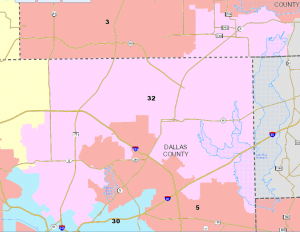That’s my takeaway after reading this.
For Pete Sessions, election night ended with yet another resounding send-off to Washington.
He won a ninth term, with 58 percent of the vote. But an analysis by The Dallas Morning News raises questions about how long the swath of Dallas and Collin counties that makes up Sessions’ 32nd Congressional District will remain safely Republican.
And more broadly, the 32nd is a microcosm of the challenges Republicans face maintaining control in congressional and legislative districts as the Hispanic population, which favors Democrats, continues to grow.
The district’s Hispanic-origin population will grow from 25.6 percent to 29.7 percent by 2016 and will only continue in years to come, according to population projections from Esri, a leading provider of demographic software and data. The percentage of registered voters in the district with Spanish surnames grew from 7.3 percent of eligible voters in 2002 to 8.8 percent in 2010.
Experts said that while changes are coming, Sessions should be safe for the next few elections.
“The big takeaway, looking at the last couple of elections in Texas, is that things are changing demographically — and that certainly has political implications,” SMU political scientist Matthew Wilson said. “But the partisan levels of those implications aren’t rising as quickly as the Democrats had hoped for.
“Change is slow, and looking at 2014 or 2016 as a tipping point might be getting ahead of the game a little bit.”
There were two competitive Congressional races this year, CD23 in which Rep.-elect Pete Gallego ousted freshman Rep. Quico Canseco, and CD14, in which Nick Lampson fell short in a race to succeed Ron Paul. The latter was basically only competitive because of Lampson, who represented a chunk of the new CD14 in his first years of service in Congress. Barring anything unusual, Rep.-elect Randy Weber will likely have a smooth ride in 2014. Only CD23 is likely to be seriously contested again.
I base this on a review of the 2008 results for the current districts and the actual results from this election. To put it mildly, there were no surprises.
Dist Obama Houston Dem Candidate Pct
=========================================
05 37.3 42.0 Mrosko 33.2
06 42.2 43.7 Sanders 39.2
07 40.4 39.1 Cargas 36.4
10 42.6 43.2 Cadien 36.2
14 42.1 47.5 Lampson 44.6
17 40.9 44.1 None 0.0
21 42.2 40.2 Duval 35.4
24 40.5 39.9 Rusk 36.0
25 42.7 43.5 Henderson 37.4
27 40.1 45.8 Harrison 39.2
31 42.5 42.4 Wyman 35.0
32 43.8 43.8 McGovern 39.4
Dist McCain W'wright GOP Candidate Pct
=========================================
15 41.8 37.3 Brueggemann 36.8
20 40.6 37.7 Rosa 33.4
23 49.3 45.0 Canseco 45.5
28 41.0 35.3 Hayward 29.7
These are all of the districts in which you could squint and see something potentially competitive based on either the Presidential number or the Sam Houston/Dale Wainwright number. Needless to say, that isn’t how it played out. Some of this is likely due to Obama’s reduced national margin from 2008, which is to say his decline among Anglo voters, some of it is likely due to the absence of resources at the state level, and some of it is likely due to the candidates themselves having little to no resources. Be that as it may, there’s nothing here to suggest there were any missed opportunities or any emerging hotspots. It’s CD23 all the way down.
There are two caveats to this. One is that we will not have the same Congressional districts in 2014. These were interim districts, to be used until the San Antonio court acts on the DC court’s denial of preclearance to fix the issues that the DC court identified. What the next map may look like and how this all may be affected by the upcoming SCOTUS review of Section 5 remains to be seen.
The other is that just because there won’t be competitive elections in November doesn’t mean there won’t be any in March. We saw one incumbent Congressman get bounced, thanks in part to some big external donors, but even if that group doesn’t play in 2014, the following members of Congress are, shall we say, less likely than some of their colleagues to make it to the next round of redistricting:
Sam Johnson, 82 years old.
Ralph Hall, 89 years old.
Kay Granger, 69 years old.
Rubén Hinojosa, 72 years old.
Eddie Bernice Johnson, 77 years old.
John Carter, 71 years old.
If nothing else, we’re likely to see a few spirited primaries in the coming years. Whether we get more than that or not remains to be seen.

